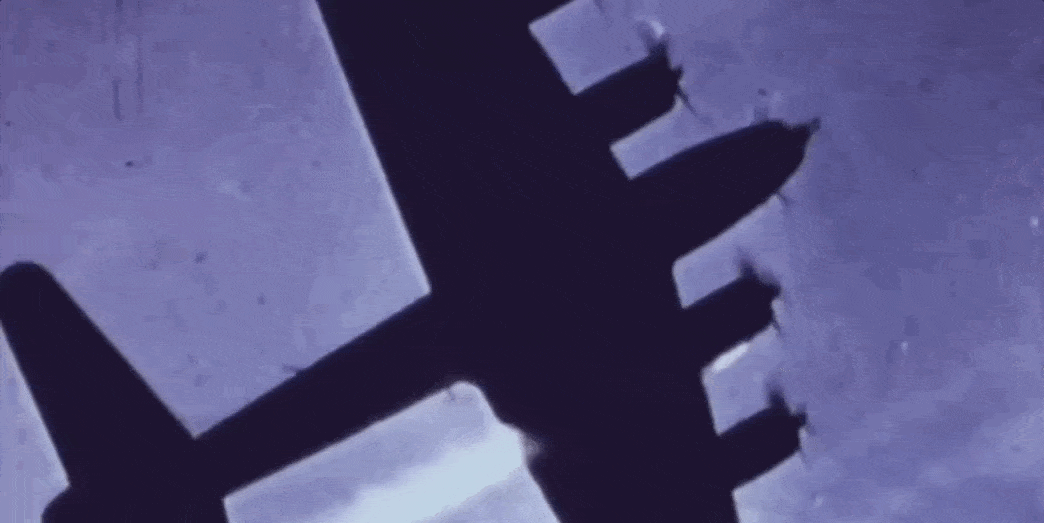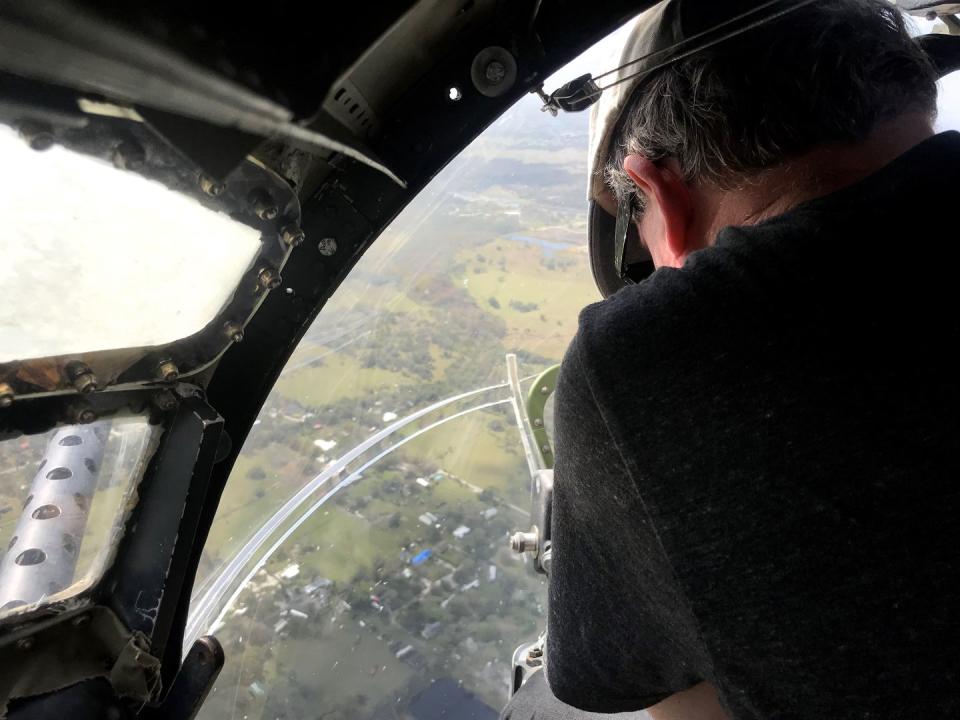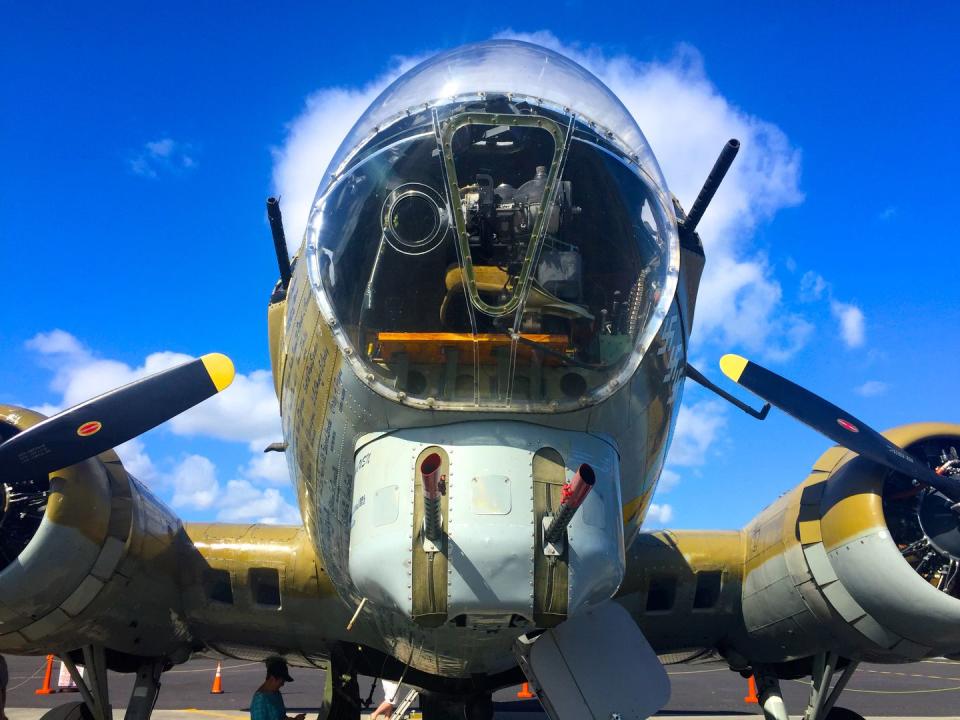A New Documentary Shows the B-17 Bomber Like You've Never Seen

The B-17 “Flying Fortress” is one of the most iconic aircraft of World War II. Built by Boeing, the four-engine bomber was the United States’ primary weapon of destruction in the air campaign to annihilate cities and bring Nazi Germany to its knees. Its combat performance was decidedly uneven, yet no one questions its primacy in the war.
The B-17E, the first mass-produced model, carried nine machine guns and a 4,000-pound bomb load. Its distinctive and enormous tail improved control and stability during high-altitude bombing. Crews loved its smoothness-“It flew like an overgrown Piper Cub,” said one pilot-and its ability to absorb enemy fire and keep flying.
“Without the B-17 we may have lost the war,” said General Carl Spaatz, commander of U.S. Strategic Air Forces in Europe.
Despite hundreds of hours of newsreel footage and its appearance in innumerable documentaries and big budget Hollywood films, however, no one has ever managed to capture what it was like to actually fly a mission in a B-17-dropping bombs on German cities while being attacked by Luftwaffe fighters and anti-aircraft fire.
That changes on May 23 with the nationwide, one-night-only theatrical screening of The Cold Blue, an extraordinary new documentary that makes use of recently discovered battle footage and miraculous film restoration technology. The film is the astounding result of a three-year labor by documentarian Erik Nelson, whose four-decade career includes producing Werner Herzog’s Grizzly Man, Discovery Channel’s Unsolved History series and numerous World War II documentaries, including Anne Frank’s Holocaust.
After discovering largely unseen B-17 footage in both American and German archives, Nelson’s groundbreaking documentary eventually drew support and contributions from late Microsoft co-founder Paul Allen, George Lucas’ Skywalker Ranch studio, sound design maestro David Hughes (Black Panther, Pirates of the Caribbean series), folk-rock legend Richard Thompson and, most importantly, nine B-17 crewmen, all now in their 90s.
Like Peter Jackson’s 2018 World War I documentary They Shall Not Grow Old-a comparison Nelson doesn’t shy from-The Cold Blue builds a mesmerizing historical journey with a one-two punch of technological wizardry and emotional but never cloying artistry. The result is one of the most visceral World War II documentaries ever produced.
“I was very influenced by (2017’s) Dunkirk, which was an impressionistic and unconventional WWII movie. It gave you the images and sounds and let you catch up with the events,” says Nelson. “But felt I could do Dunkirkone better because my footage was real.”
Resuscitating History

After being commissioned by Allen’s Vulcan Productions to research color footage of World War II aircraft, Nelson stumbled into an astonishing find. At the National Archives, a researcher named Elizabeth Hartjens casually mentioned the existence of 15 hours of color outtakes shot in April-May 1943 by director William Wyler for his famed documentary Memphis Belle, about a B-17 and its crew.
“I knew right then this would be the project,” says Nelson. “This is a treasure beyond all imagining. It’s the King Tut’s tomb of World War II archival footage and attention must be paid.”
Released in 1944, Memphis Belle was essentially a propaganda film commissioned by the U.S. government to, in Nelson’s words, “justify the incredible investment in money and human lives that was going on in 1943 and ‘44 in the skies over Germany and justify why all those telegrams were going out to homes around the United States.”
Nelson and his team pored through Wyler’s unused footage. After an assist from Criss Austin, a motion picture preservation specialist with the National Archives, who transferred the original 16mm film to 4K, they went to work digitally fixing dust spots, scratches and restoring faded color. Most crucially, they eliminated a large and hideous blue line that, due to an error at the original processing lab in London, marred every frame of Wyler’s film.
The larger problem was sound. Or lack of it. None of Wyler’s film was shot with audio. Nelson wanted to create a “big-screen, time travel, see-it-in-a-theater-in-the-dark-with-surround-sound portal into the past.” He couldn’t do that without sound.
To remedy the situation he enlisted Hughes and found one of a handful of still-operational B-17s. On a 90-minute flight from Vero Beach to Naples, Florida, in a B-17 owned by the Collings Foundation, Hughes mounted microphones in 18 positions around the plane precisely matching the spots from which Wyler shot his original footage.
The microphones and audio equipment came on loan from Lucas’ Skywalker Ranch, where the final mix was done with help from legendary soundman Ben Burtt (Star Wars series, Raiders of the Lost Ark, Blade Runner). During that process, Burtt confirmed to Nelson that he and Lucas had watched Wyler’s Memphis Belle over and over again while they were creating the original Star Wars battle scenes.
“I was able to fly in the front of the B-17 surrounded by the Plexiglas nose,” says Nelson, recalling images of Han Solo’s Millennium Falcon. “I’m not sure there’s anything flying today in any kind of airframe that’s clear all around where you’re literally sitting suspended in a plastic bubble while moving 200 mph across the earth. I called it the God spot.”
Hughes was just as meticulous recording outside the plane. To match sound to a sequence of six different B-17s taking off, he recorded takeoffs from six different positions on a runway to capture the sounds from spots Wyler had placed his cameras, recreating events as Wyler would have heard them.
“If you see a shot from a certain angle you’ve got stand next to a B-17 and record the sound from the same angle,” Nelson says. “You can’t mess around with history. If you’re publishing for the ages you gotta get it right.”

The team was just as careful with the sounds of German anti-aircraft fire, known as flak. In movies, flak is often represented as a big boom.
“It doesn’t sound like that, it’s a subcutaneous noise,” says Nelson. “One former crewman told us it sounded like you’re in a storm drain and someone throws gravel on top of an aluminum pipe. Shrapnel doesn’t explode. Flak shrapnel is fragments penetrating a thin aluminum shell.”
Those terrifying sounds and subcutaneous sensations were common during missions. Following the war, one B-17 veteran sent the Boeing Company a letter explaining how he returned to England after a bombing raid over Germany in a B-17 with 179 flak holes and only two of the four engines operating.
A Whole New Documentary Genre
The Cold Blue isn’t narrated in the traditional sense.
“My original one-liner was ‘It’s Koyaanisqatsi with B-17s,” says Nelson, referencing the groundbreaking 1982 experimental film that presented a visual poem of natural landscapes with no narration and a minimalist Philip Glass score.
Text slates provide some context, but otherwise The Cold Blue story is stitched together with audio clips from nine B-17 crewmen Nelson interviewed around the country. One man describes watching a fatal episode in which a nearby B-17 flying in tight formation accidentally descended on top of another sending both planes and all crew to their deaths. “That’s when I started smoking by the way,” the man concludes with a rueful laugh.
Aside from a brief introduction, none of the veterans make a physical appearance until the end of the film. Traditional World War II documentaries tend to toggle between old footage and postwar interviews with survivors.
“It wrenches you out of the moment,” says Nelson. “My intention with The Cold Blue was to put it together with the sensibility of a 21st-century documentarian.”
The most effective example of contemporary sensibilities is a tight shot of three American mechanics examining a B-17 engine cowling on a typical English airfield. Wyler uses a large boom to pull back the camera on a lush country setting with an ancient stone church in the background. It’s the most cinematic moment of the film, even if Wyler himself didn’t recognize it.
“That (tight) shot is in Memphis Belle, but what isn’t in Memphis Belle is the pull-out, which is inexplicable to me,” says Nelson. “That one shot summarizes my intentions with The Cold Blue. Filmmakers had different sensibilities in the 1940s. They wouldn’t let shots play out their full length. There are a number of shots in The Cold Blue we let go for the whole shot. That’s what filmmakers do today.”
To augment his modern aesthetic, Nelson signed on renowned British musician Richard Thompson, who composed and recorded a score riven with haunting strings and melancholy acoustic guitar. Born in 1949, Thompson grew up playing in the rubble of bombed-out London.
“They didn’t clear all the rubble out till the early ‘60s,” says Nelson, who had collaborated with Thompson on four previous films. “There wasn’t an English kid of that time who didn’t play in bombed-out buildings.”
Although during filming Nelson wasn’t aware of Peter Jackson’s then in-progress They Shall Not Grow Old, he now sees both films as part of an emerging genre.
“When I heard about Jackson’s film I instantly thought, ‘Uh oh, incoming, competition,’” he says. “But secondly I thought, ‘Oh, I’m not the only one who thinks this might work.’ It was kind of reassuring.”
Nelson believes he, Jackson and director Todd Douglas Miller-whose majestic 2019 documentary Apollo 11uses never-before-seen 70mm footage shot during the 1969 NASA moon mission-are creating a new type of documentary genre.
“It’s interesting that all three films came out within about a year of each other and all of them fall into this impressionistic history arena,” says Nelson. “All three of us were consciously thinking of theatrical big screens as a time-travel machine to immerse the viewer in the motion and events.
"In this bifurcated political era not only are filmmakers attracted to material like this, but the technology has caught up with the history, so we are able to make these films."
The Cold Blue will eventually appear on HBO, but beyond the big-screen and surround-sound experience, there’s another reason to see it first in a theater. Presented by special events company Fathom, the May 23 showing will exclusively feature a restored cut of a Nazi propaganda newsreel recently uncovered in Berlin archives. With surprising honesty, it depicts the inhuman devastation B-17s wreaked upon German cities.
“That footage just blew my mind when we came across it,” says Nelson. “No American ever shot footage like that of that destruction. If Wyler had shot footage of the destruction caused by B-17s it never would have come home.”
The theatrical screening is also the only way to see a 25-minute “making of” documentary that in its own way is as revealing as the feature film. As bookend events, The Cold Blue does for World War II documentaries what They Shall Not Grow Old did for World War I films. For anyone interested in the war, aviation or the electrifying new direction of historical documentaries, it’s essential viewing.
('You Might Also Like',)

